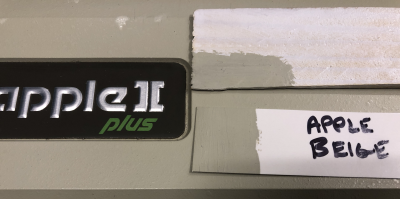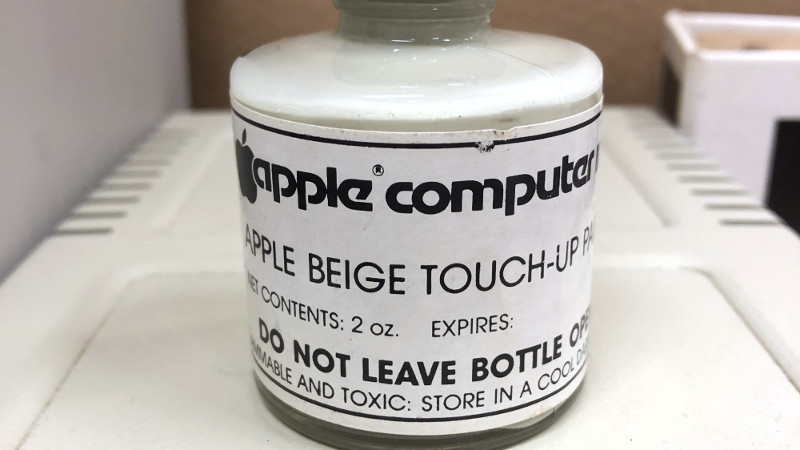If we cast our minds back a few decades, almost all computers were a beige colour. “Beige box” even became a phrase for a generic PC, such was their ubiquity. Long before PCs though there were other beige computers, and probably one of the first to land on the desks of enthusiasts rather than professionals was the Apple ][. But exactly what beige colour was it? It’s a question that interested [Ben Zotto], and his quest led him through a fascinating exploration of a colour most of us consider to be boring.
 We’re used to older beige computers becoming yellow with time, as the effect of light and age causes the fire retardants in their plastic to release bromine. But the earlier Apple products haven’t done this, because their beige came not from the plastic but from a paint. [Ben] was lucky enough to find a small pot of touch-up paint from Apple that was made available to dealers, so notwithstanding any slight pigment changes from its age, he set off in pursuit of its origin.
We’re used to older beige computers becoming yellow with time, as the effect of light and age causes the fire retardants in their plastic to release bromine. But the earlier Apple products haven’t done this, because their beige came not from the plastic but from a paint. [Ben] was lucky enough to find a small pot of touch-up paint from Apple that was made available to dealers, so notwithstanding any slight pigment changes from its age, he set off in pursuit of its origin.
Along the way to identifying a modern Pantone shade (Pantone 14–0105 TPG, for the curious) he treats us to a cross-section of Apple’s early colour history with reference to the memories of early Apple luminaries. He even suggests readily available shades that could suffice, pointing to Gloss Almond Rust-Oleum spray paint.
So should you wish to colour-match to an early Apple, now you can. If you have a Commodore or an Atari though, maybe your task is a little easier.
















That looks too gray/green, but that may just be due to color camera/monitor profile variation.
When did you last calibrate your monitor would be the first question, since the video is a done deal.
I guess it went like this:
1. Steve Jobs wants a special beige.
2. Steve Job gets talked into regular Pantone 453 because it’s easier to source.
3. The paint company delivers some other beige, no one notes the difference.
4. Finally, Ben Zotto notes the difference
Weren’t we discussing a short while ago here on Hackaday that flame retardants aren’t the primary cause of the yellowing, but it comes instead from structural changes in the ABS plastic due to oxidation?
https://hackaday.com/wp-content/uploads/2021/01/The-Retrobright-Mystery.pdf
“…a colour most of us consider to be boring.” So now everything is black.
How can you kill that which is already dead?
How can you consider it a boring color if it has no color? ;)
But is every thing the SAME black?
“And after it rains, there’s a rainbow,
but all of the colors are black.
It’s not that the colors aren’t there,
it’s just imagination they lack.
Everything’s the same fact.
-My Little Town (Simon and Garfunkel)
It wasn’t the color that’s boring it’s the basic rectangle box without any useful front io. Who else remembers putting the tower on your desk backwards so you could easily reach the ports on the back? Just ordered some almond gloss, I’ll see how accurate it looks compared to my brains memories.
“Who else remembers putting the tower on your desk backwards so you could easily reach the ports on the back?”
From a time and motion point of view that just sounds silly.
Funny you should say that. There was a front panel one could buy that brought the back panel out to the front.
I’ve always added multi-function panels to the front of my desktop builds. I never considered turning the computer around, as the back panels are just too ugly.
“…you can order it in any color just as long as it’s black…” – Henry Ford
Does colour rhyme with velour?
Anyone dealing with appliance repair has most likely come across the multitude of beige touch-up enamel shades and has had a debate with some scruffy-looking redneck guy over whether something is bisque, biscuit or bone.
I used Gloss Almond Rust-oleum as a substitute for “Tacoma Cream” on my old Ford truck.
Looks like somebody forgot a nail varnish in the fridge some 30 years ago.
That would be #C4C0AA to us hackers.
Back in the 1980s I made an accessory for the C64 which we wanted to match the C64’s color of possible. I visited the paint store, and learned it’s not just the color but the light source. He put the C64 inside a special light box along with some painted samples. He could simulate various lighting conditions such as sunshine, incandescent, fluorescent, etc.
And not for nothing but different photographic films emphasize different colors: Kodak, red and yellow; Fuji, blue. It’s right there on the box.